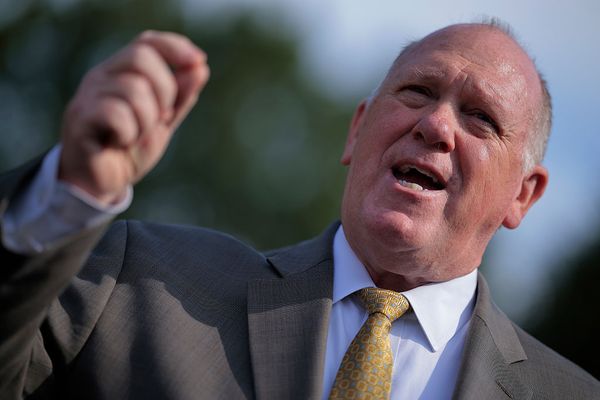
Italy will vote for a new national government on September 25. The outcome of the parliamentary elections could have dramatic effects on the country, the European Union, and NATO. If polling numbers are correct, a right-wing coalition will win a convincing majority and the far-right Brothers of Italy Party (Fratelli d’Italia) will put forward its leader, Giorgia Meloni, as the country’s first far-right prime minister since Benito Mussolini. Meloni rejects any connection to fascism, but her party retains many of the symbols and values of Italy’s fascist past. Small wonder, then, that the prospect of her gaining power has spooked markets and international observers alike.
Yet despite international worry over her ascent to power, a strong Meloni may be preferable to a weak one. She is now shedding her formerly populist public image, instead presenting herself as something more like a traditional conservative. Her policy preferences broadly fit within both EU and NATO directives. It is thus not Meloni who poses the biggest risk to Italy’s stability and its place in the West. It is her likely coalition allies, particularly the Russia-friendly Lega Party and its often disruptive leader, Matteo Salvini.
In the long term, Meloni may harm Italy’s democracy. She has clear ambitions to strengthen the power of the executive over parliament and to solidify her own position. Her conservativism and her constitutional reform agenda will spark controversy within Italy and across Europe. But in the short and medium term, a strong Meloni will prove more stabilizing than disruptive, whereas a weak Meloni may have to compromise with Salvini in ways that Italy’s allies will find unpalatable. A very poor showing by Meloni could leave Italy without a government at a time of national crisis.
RETURN OF THE RIGHT
Italy’s experience of fascism—its suppression of democracy, its colonial ambitions, its alliance with Nazi Germany, and its involvement in the Holocaust—led to a great deal of soul-searching in the wake of World War II. Immediately after the end of the war, some Italians struggled to accept that fascism was to blame. Instead, they argued that Mussolini’s chief errors had been not his domestic agenda or ideology but his alignment with Nazi Germany.
Former fascists created a parliamentary party, the Italian Social Movement, which regularly ran in national elections and pursued socially conservative goals while attempting to bring far-right ideas into the mainstream. However, other parties systematically excluded it from government, and the U.S.-aligned, centrist Christian Democratic Party dominated successive Italian governments. Its main rival was the Soviet-aligned Communist Party. The far right emerged at key moments, usually to support the Christian Democrats against the communists, but it rarely rose to prominence and none of its members ever held high offices.
The isolation of the far right ended after the end of the Cold War, when the Italian Communist Party and the Christian Democrats collapsed, creating a political vacuum that left space for a new kind of populism. Parties such as the separatist Northern Leagues (later to become Salvini’s Lega) pledged to carve out northern Italy as an independent country. And a billionaire media mogul, Silvio Berlusconi, became prime minister promising to replace the professional political class with business leaders. In this context, right-wing politicians began to return from political exile and participate in government. The Italian Social Movement rebranded as the National Alliance and entered successive Berlusconi-led governments in 1994, 2001–6, and 2008–11 while carefully putting some distance between itself and the fascist tradition from which it emerged. For example, the party’s leader, Gianfranco Fini, visited a Holocaust museum in Israel in 2003.
AGAINST THE ELITES
Somewhat counterintuitively, the return of right-wing parties to government did not spark political polarization. On the contrary, in the 1990s, Italian voters generally began to gravitate toward the center. Berlusconi evolved from a populist firebrand to a mainstream center-right politician, an evolution driven by his competition with the center-left leader Romano Prodi; the two men spent more than a decade trading the office of prime minister back and forth. The National Alliance also moved to the center. In doing so, it gradually lost its political identity, becoming increasingly hard to distinguish from Berlusconi’s party, Forza Italia, as the two parties campaigned together as the People of Liberty.
That convergence of political opinions came to a halt after the eurozone crisis brought down Berlusconi’s last government, in 2011. Italy’s established political parties failed to respond effectively to the crisis, disillusioning voters. New, small protest parties benefited the most. As part of a wider revolt against Italy’s traditional elites, Meloni, the youth minister in Berlusconi’s final cabinet, created the Brothers of Italy in 2012, driven by a sense that the National Alliance had betrayed its core values.
The appeal of Meloni’s right-wing politics was limited at first. In the 2010s, the Brothers of Italy won only between two and four percent of the vote during national and European elections. Voters were far more enthusiastic about the antiestablishment, anti-European Five Star Movement, which won more than 25 percent of the vote in national elections in 2013 and more than 32 percent in 2018. Voters across Italy also started to flock to Salvini’s right-wing, anti-EU, nationalist Lega party, which won more than 17 percent of the vote in national elections in 2018 and more than 34 percent in elections for the European Parliament a year later.
Five Star and Lega formed a coalition government in June 2018. This started a process whereby the two parties transformed from outsider groups into something closer to traditional elites. They compromised on their choice of finance minister, made concessions to the European Commission on the budget, and failed to reform pensions and labor markets as they had promised. In 2019, the transformation continued when Five Star formed a new government with the center-right Democratic Party, and culminated in 2021, when both Five Star and Lega joined Prime Minister Mario Draghi’s national unity coalition along with Berlusconi’s party and the Democratic Party. Meloni and her Brothers of Italy remained outside each of these coalitions and so emerged as the main voice of opposition.
Meloni is buoyed by voters seeking a fresh face.
Meloni’s choice to stay outside Draghi’s coalition gave her a distinct advantage over both Five Star and Lega. The Draghi coalition represented everything that Five Star and Lega had once rejected. Draghi is a technocrat who, before accepting the post of prime minister in 2021, had been president of the European Central Bank. As prime minister, his policies were centrist and pro-EU. His main goal was to prepare Italy—by reforming its courts, civil service, and other institutions—to receive European support for its recovery from the pandemic.
Draghi also represented a method of governing that allowed for little internal protest. He held together his coalition by insisting on consensus and collective responsibility. This implicated Five Star and Lega in every stage of the difficult institutional reform process, and gave Meloni and her Brothers of Italy ammunition to claim that both parties were guilty of hypocrisy.
Five Star and Lega thus dropped steadily in the polls during Draghi’s tenure, as their decision to support an establishment-led government was seen by voters as the final act of disavowal of their former populist principles. In late July, both saw an opportunity to escape their seemingly irreversible decline. When Five Star refused to support a social-assistance bill, Lega and Forza Italia refused to continue in government with Five Star, stating that the party had proved unreliable. Draghi, who had always demanded consistency and loyalty from his parliamentary supporters, had no choice but to end the coalition.
The end of the Draghi coalition has given a further boost to Meloni, who is now also buoyed by voters seeking a fresh face. According to recent polls, the Brothers of Italy are now on track to capture over a quarter of the national vote.
MAINSTREAM MAKEOVER
Now that Meloni has consolidated her leadership among protest voters, she has every incentive to present herself as a reliable prime minister in waiting and to bolster her international credibility. She knows that the long-term viability of her government will depend on whether markets accept her leadership. She is thus making efforts to appear mainstream. Recently, she reassured allies that her government would remain committed to supporting Ukraine. She also clarified that, contrary to her previous pronouncements, she unequivocally supports Italy’s membership in the eurozone. And the joint election manifesto that Meloni agreed on with Salvini and Berlusconi is broadly reassuring to moderates: it promises “respect for [Italy’s] commitments as part of the Atlantic Alliance” and “full adherence to European integration.”
Salvini wants to challenge Meloni’s leadership, and he can do so only by clawing back the protest vote. His strategy is to outflank Meloni on the extremes. Lega has proposed a flat tax to replace the existing progressive income tax and a pension reform that would give every Italian access to a full pension after 41 years of employment. Estimates suggest that these plans alone would cost an additional 57 billion euros annually, roughly 3.3 percent of gross domestic product. Such plans for heavy borrowing would likely spark another budget showdown with Brussels, similar to one that Salvini engineered in 2018. In turn, this might create another market crisis of confidence in Italy, a highly indebted economy facing poor demographic prospects and a grim forecast for economic growth. It would be made worse by the fact that the European Central Bank has made it clear that it will not step in to prevent market turmoil in member states that do not abide by Brussels’s fiscal rules. A crisis of confidence in Italy’s ability to service its debt might call into question the long-term viability of the common currency, as it did in 2011-12. From a geopolitical standpoint, too, Salvini’s stance is unreliable. A few weeks ago, he publicly called for a reconsideration of EU sanctions on Russia, though he later backtracked.
Salvini’s strategy is to outflank Meloni on the extremes.
Salvini points to rising prices and interest rates faced by Italians to defend his proposed tax cuts, pension reforms, public-spending increases, and softening of the EU’s response to Russia’s war on Ukraine. He claims to be a man of the people. To avoid being outflanked by him, Meloni will have to convince Italians that high energy bills are an acceptable price to pay for the long-term security of Europe and that massive fiscal transfers are not a responsible way to deal with the economic hardships they are facing. Neither argument will be easy to make: 51 percent of Italian voters would like to end sanctions on Russia, according to a recent poll. That proportion is likely to grow as winter sets in.
The difficulty for Meloni is to find a way to moderate or accommodate Salvini without reducing her credibility with EU partners and international investors. By compromising with him on these issues, Meloni would risk fracturing the West’s united front on Ukraine, starting a fight with the EU over budgets, or both—a nightmare scenario. Even if Meloni holds firm, the very presence of a strong Salvini within her government would raise doubts about how long she would be able to sustain his pressure.
FIGHT ON THE RIGHT
Salvini will be able to pressure Meloni only if he maintains a firm control over Lega. His party is internally divided between radicals who want to preserve the party’s status as a voice of protest and moderates who want to move toward the center and who think Salvini missed an opportunity when he contributed to the collapse of Draghi’s government. There are signs that important parts of the business community are warming to Meloni’s more moderate stance. At the annual Ambrosetti Forum at Cernobbio, Italy’s most important gathering for high-profile industrialists, financiers, and businesspeople, she won plaudits by promising continuity with the broad goals outlined by Draghi. Salvini cannot afford to lose this key constituency.
If Lega gets less than ten percent of the vote, a poor showing for Salvini, he will need to shore up his position within his own party instead of sparring with Meloni. That will leave Meloni freer to moderate her policies and bolster her government’s credibility within Europe, NATO, and the bond markets without interference from her unreliable ally.
The other possible outcomes are less attractive. A poor result for Meloni could result in a fragile right-wing government that would likely collapse well before the end of parliament’s five-year mandate, and possibly in just months, forcing Italy to re-run elections with the cost-of-living and energy crisis in full swing. Even worse would be a very weak showing by Meloni that might leave her unable to form a coalition at all, given the deep divisions on the center-left and the inability of the Brothers of Italy to govern with the Democratic Party. This would leave Italy without a government at a moment of national crisis.
A good showing by Meloni would at least offer stability and allow her to take responsibility for governing Italy. By softening her formerly populist stance considerably over the past months, Meloni has shown that she understands the stakes. Over the long term, Italians will have to judge her far-right agenda and her plans to transform their democracy. But in the short term, for Italy—and for EU, the United States, and Ukraine—a strong Meloni would be better than a weak one.







